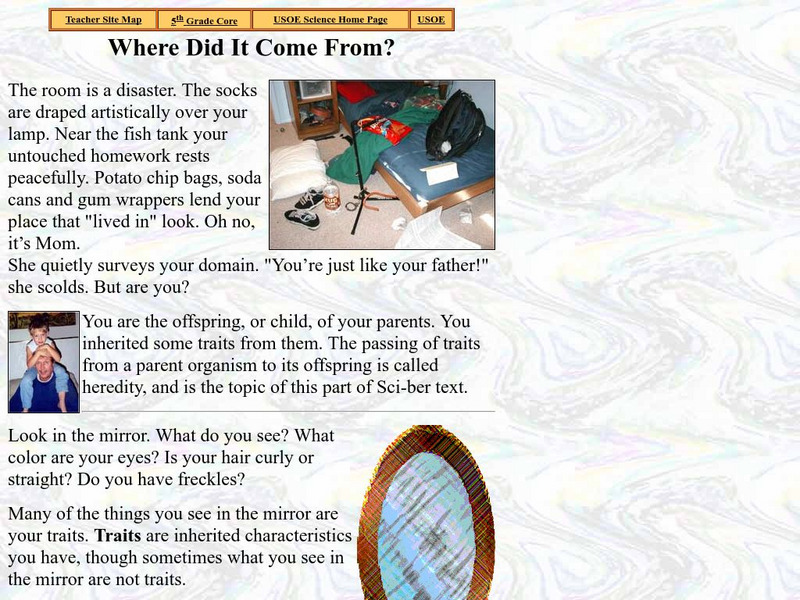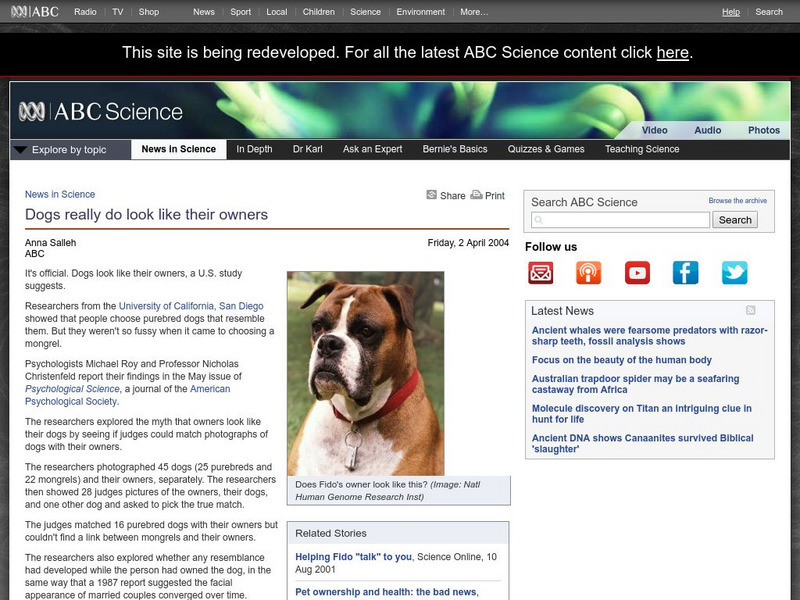Hi, what do you want to do?
The Science Spot
Bikini Bottom Genetics 2
In this biology worksheet, learners use the information given on genetics, Sponge Bob and other characters to complete each of the questions on the sheet. They write the phenotype for each stated trait. Students also determine the...
Curated OER
SpongeBob Genetics Quiz
In this biology worksheet, students use the information given to complete each of the questions. They indicate whether each genotype is heterozygous or homozygous. Students also complete the Punnett square to illustrate the possibilities...
Curated OER
Heredity: Your Connection To The Past
Learners investigate genetics and the process of reproduction in living organisms.
The Science Spot
Bikini Bottom Genetics
Hilarious! Use the characters from SpongeBob Square Pants to practice solving genetics problems! Yellow sponge body color is dominant to blue. Square body shape is dominant to round body shape. Did someone switch Mr. Krab's baby...
Core Knowledge Foundation
Genetics and the Master Race
How did the beginnings of genetic research influence the Nazi party? A thorough, engaging unit incorporates the work of Gregor Mendel, the study of inherited traits, and the use of racism and discrimination during the Holocaust.
Curated OER
The Large Animal Industry
Focusing on the large animal industry the production of meat products, this information may prove to be sensitive matter to some members of your class. However, the slides are relevant. They delve into the topic of animal labor....
Curated OER
Bikini Bottom – Dihybrid Practice
In this biology worksheet, learners use the chart to identify the genotypes of each of the traits listed related to Sponge Bob. Then they identify the genotypes of each of the family members as given. Students also complete the Punnett...
Curated OER
Canine Companions: All Kinds of Dogs
In this family dog lesson, learners discover how to choose the type of dog that best fits their family. Students research different types of dog breeds, and share with the class the type of dog they would choose for their family. A...
Curated OER
Good Breeding
Third graders investigate a variety of cattle breeds common in Oklahoma. They complete a worksheet on their vocabulary words, and locate on a world map the locations where the cattle breeds originated. In addition, they view several...
Curated OER
Using the Internet: Punnett Squares
Seventh graders discuss their own genetic traits. Using computers, they research the creation of Punnett Squares. They preform online experiments with peas, predicting the appearances of the offspring. They determine how genetic traits...
PBS
Pbs Learning Media: Some Genes Are Dominant
This interactive activity, adapted from the Dolan DNA Learning Center, illustrates how Gregor Mendel used purebred yellow and green peas to show that some genes are dominant and others are recessive.
Cold Spring Harbor Laboratory
Dna From the Beginning: Genes Come in Pairs
This animated lesson will explain how genes are inherited in pairs, one from the mother and one from the father.
Utah State Office of Education
Utah Science: Where Did It Come From?
Is your room a mess? Does your nose have freckles on it like your mom's? Are your eyes the same color as your dad's? Which one of these things does not belong in lessons about heredity? Give these investigations a whirl while learning...
Virtual Museum of Canada
Virtual Museum of Canada: Community Stories: t.b. Macaulay and Mount Victoria Farm
Because of T. B. Macaulay,early president of Sun Life Insurance,a small herd of Holstein cattle grow to become one of the most purebred herds in the world today. Archival photographs and stories of the family and farm are included.
Australian Broadcasting Corporation
Australian Broadcasting Corporation: News in Science: Dogs Really Do Look Like Their Owners
From ABC News in Science, Anna Salleh's article discusses the findings of a U.S. study related to dogs looking like their owners. The study also deals with the purebred vs. mongrel issue in choosing a dog.


















